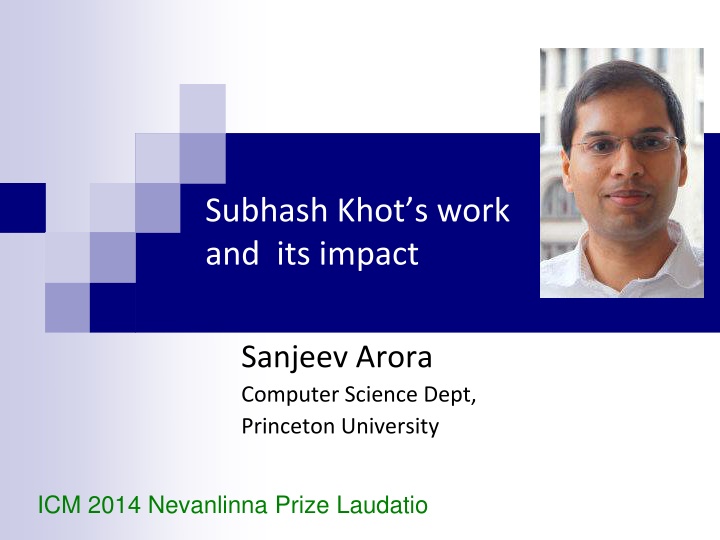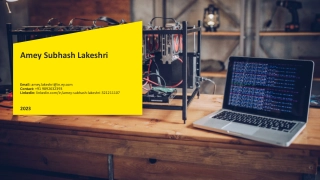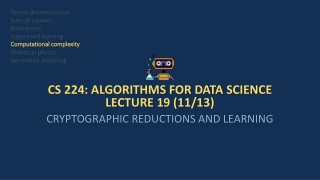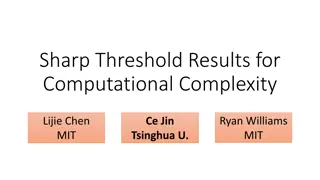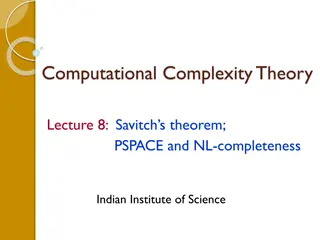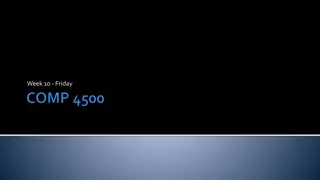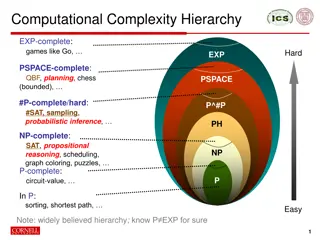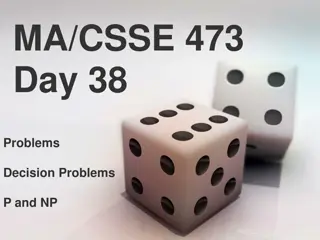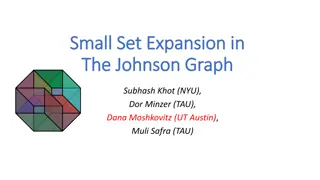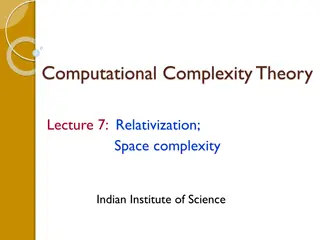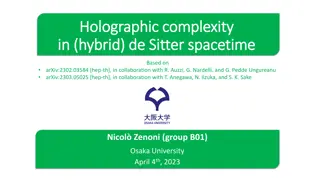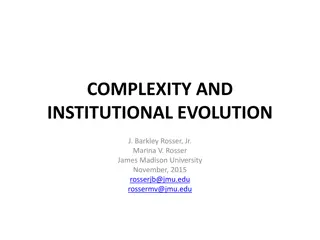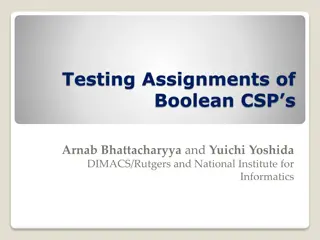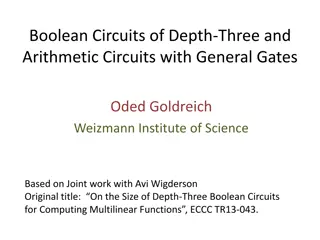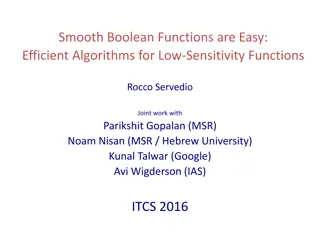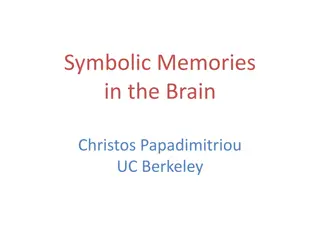Unveiling the Impact of Subhash Khot's Work on Computational Complexity
Subhash Khot's work on the unique games problem, NP-complete problems, and approximability has greatly influenced computational complexity theory. Explore the challenges, breakthroughs, and implications in characterizing computation time and solving NP-complete problems.
Uploaded on Feb 15, 2025 | 1 Views
Download Presentation

Please find below an Image/Link to download the presentation.
The content on the website is provided AS IS for your information and personal use only. It may not be sold, licensed, or shared on other websites without obtaining consent from the author.If you encounter any issues during the download, it is possible that the publisher has removed the file from their server.
You are allowed to download the files provided on this website for personal or commercial use, subject to the condition that they are used lawfully. All files are the property of their respective owners.
The content on the website is provided AS IS for your information and personal use only. It may not be sold, licensed, or shared on other websites without obtaining consent from the author.
E N D
Presentation Transcript
Subhash Khots work and its impact Sanjeev Arora Computer Science Dept, Princeton University ICM 2014 Nevanlinna Prize Laudatio
Main points from Nevanlinna Prize Citation Defined unique games problem between P and NP-complete and conjectured it is hard. Showed how this leads to precise characterization of approximation ratios achievable for various NP-complete problems. Unconditional new results in isoperimetry, analysis of boolean functions, distortions of metric space embeddings, New connections to Math.
Computational complexity Goal: Characterize computation time needed to solve a problem Ideally, should (a) design algorithm running in time T. (b) show no other algorithm running in << Ttime solves the problem Very little progress on (b), so we try to prove (b) modulo famous conjectures.
Example: P vs NP NP-complete: Every NP problem reducible to instance of this problem in nc time. (e.g Traveling Salesman,MAX-CUT, Satisfiability, Integer Programming, 1000s of others) NP a good solution can be checked in nc time. P solution can be found in polynomial time i.e. nc (n= input size ) P =? NP Can brilliance/creativity be automated? P NP NP-complete problems cannot be solved in nc time. (Limits on math/science/social science theories)
An NP-complete problem: MAX-CUT Goal: Partition vertices into two sets to maximize number of cut edges Decision version: Given (G, K), does G have a cut with at least K edges? Qs: What is complexity of finding approximately optimal solutions?? (For this and thousands of other problems) Of great practical & mathematical interest ( Approximate characterizations ).
Approximability seems problem-dependent Traveling salesman: Can find tour of cost 1.5 OPT. [Christofides 76] Approximation ratio is 1.5 Vertex Cover: Can find cover of size 2 OPT[folklore] Hundreds other such approximation algorithms. (Tremendous effort in last 25 years.) Are there limits to how well we can approximate?? (Great progress in last 25 years ---modulo conjectures)
Example: Approximability of MAXCUT MAXCUT: Partition vertices into two sets to maximize number of cut edges [Goemans,Williamson93]: Can find cut s.t. # cut edges > 0.878 MAX-CUT(G) Inapproximability result [Hastad97] Achieving approx. ratio 0.95 implies P =NP. Hastad sPCP Theorem . Threshold result [Khot, Kindler, Mossel, O Donnell 04, Mossel, O Donnell, Oleskiewicz 05] Achieving approx. ratio 0.878 + implies unique games conjecture (UGC) of [Khot02] is false.
Story in a nutshell Interesting approximation algorithms for many NP-complete problems Vast literature on inapproximability results ( PCP Theorems ; goes back to early 1990s). Work of Khot + others (post-2002) For significant group of problems, threshold of approximability determined (assuming Unique Games Conjecture)
x-y = 11 (mod 17) x-z = 13 (mod 17) . z-w = 15(mod 17) Unique Game Problem E2LIN mod p Given a set of linear equations of the form: Xi Xj = cij mod p Find solution that satisfies the maximum number of equations. Unique Games Conjecture (KKMO 04 version): Given instance in which 0.99 fraction of equations are satisfiable, it is NP-hard to satisfy more than 0.01 fraction.
UGC standard approximation algorithms (SDP or LP based) optimal for . Vertex cover [Khot-Regev 03] Grothendieck Problems [KNS`08, RS`09] UGC Kernel Clustering Problems [Khot Naor`08,10] Constraint Satisfaction Problems [Raghavendra`08] MAX CUT, MAX 2SAT Strictly Monotone CSPs [KMTV`10] VERTEX COVER, HYPERGRAPH VERTEX COVER Metric Labeling Problems [MNRS`08] MULTIWAY CUT, 0-EXTENSION Told ya In many cases, failure of the standard algorithm (on a single instance) can be converted into an inapproximability result!!
Efforts to apply/prove/disprove UGC have also yielded a treasure trove of new (unconditional) results in: Analysis of Boolean Functions, Harmonic Analysis Isoperimetry, Invariance principles etc. High dimensional geometry Embeddability of metric spaces into each other
Analysis of boolean functions (and why it is relevant) [Kahn-Kalai-Linial 88, Hastad 98,Khot-Kindler-Mossel-O Donnell 04] Voting scheme: f : {0,1}N {0,1} Collective decision = f(x1, x2,.. xN) N voters; i th one votes xi 0/1 Noise stability : Probability this decision doesn t change if random subset of fraction of voters flip their votes For Dictatorship (ie f(x1, x2,.. xN) = xi): this is 1- . What is stablest function that is not close to dictatorship? Answer: Majority! ([Mossel, O Donnell, Oleskiewicz 05]: invariance principles; isoperimetry)
(0.878 + )-approx to MAX-CUT poly-time algorithm for UG [KKMO 04] Hard instance for [GW93] algorithm for MAXCUT! x-y = 11 (mod 17) x-z = 13 (mod 17) . z-w = 15(mod 17) 17 Dimension hypercube 17 Dimension hypercube Convert UG instance into a graph. 17-dimensional hypercube for each variable Connect point p of x with q of y iff p, q make the angle GW. (Coordinate i of x identifies with coordinate (i+ 11)mod 17 of y.) If the constraint is, say, x-y =11 (mod 17) Majority is stablest + Harmonic analysis approximately optimum cuts in the graph decodable to good solution for UG instance (Aside: 0.878.. corresponds to noise stability of majority)
Low-distortion embeddings of metric spaces How similar are two metric spaces (X, d1) and (Y, d2)? Important in analysis, also in algorithm design (e.g. if input is from X and our algorithm works for Y). X Y Distortion of f: X Y is smallest C s.t. d1(x1, x2) d2(f(x1), f(x2)) C d1(x1, x2) f [Bourgain 85]Every n-point metric space has an embedding into l2 with distortion O(log n). (Many algorithmic applications after [Linial, London, Rabinovich 94]; big research area )
Goemans-Linial Conjecture Every finite metric space of negative type embeds into l1 with distortion O(1) ( negative type : Euclidean and d(x1, x2)2 + d(x2, x3)2 d(x1, x3)2) If true, would yield O(1)-approximation for graph partitioning problems via semidefinite programming. (Also, would disprove UGC [Khot + others]) [Khot-Vishnoi 05] False; Distortion log log n. (Improved to (log n) by [Cheeger, Kleiner, Naor 09] ) (Main idea: Cleverly constructed negative type metric, motivated by insights from UG. Greatly generalized by [Khot-Naor 05] to apply to other metric embedding problems.)
Foams, parallel repetition, unique games What is smallest surface area of shape in Rd such + Zd tiles Rd? ( Foam problem; posed by Kelvin for d=3) Unit cube 2d is an upper bound. d=2 Unit sphere ( d) is a lower bound. [Kindler, O Donnell, Rao, Wigderson 12] Foam construction with area O( d); also best construction for d =3. ( Spherical cubes ) Construction inspired by a counterexample of Raz to a well-studied approach for proving UGC.
New analyses of Semidefinite programs; Higher-order spectral graph theory. SDP: subcase of convex programming. [Khot02] suggested it as a way to try to disprove UGC (i.e., give a good approximation to UG problem) [Arora, Khot, Kolla, Steurer, Tulsiani, Vishnoi 08]Used SDP to show that UG problem is easy when constraint graph is random or random-like ( expander ); SDP + eigenvalue methods ( high order spectral graph theory ) lead to subexponential algorithms for UG problem [Arora, Barak, Steurer 10], [Barak,Raghavendra, Steurer 11], [Guruswami-Sinop 11]. Many recent results about connection of higher eigenvalues to graph expansion
Other contributions of Khot Inapproximability results that don t rely on UGC (only on P NP): Shortest Vector in Integer Lattice, Max-Clique, Hypergraph Vertex Cover and Coloring, Metric Labeling, Learning parities with noise, Lowerbounds for approximation ratios achieved by SDP hierarchies Best progress to date on proving UGC (NP-completeness for a similar problem over R). [Khot-Moshkovitz 11]
In conclusion Khot s 2002 definition of UG problem and UGC proved very prescient and subsequent work (including his significant contributions) led to an exciting decade of new discoveries in theoretical CS and math, with more to come. (Unanticipated by most experts, certainly by me.). Congratulations, Subhash!!
